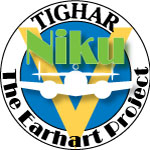| Dateline: Nikumaroro, 1630 Local Time, 21 July 2007. |
The taphonomy experiment is set up and already progressing
nicely; the pig bones are covered with small hermit crabs, strawberry hermit
crabs, and coconut crabs, all munching happily away.
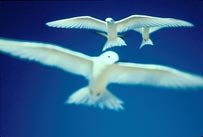 In
the village, four of the crew from Nai’a volunteered to
help clear brush, resulting in about a 400% increase in productivity. Although
the work cannot be made light, many hands do help spread the load. All brush
is being cleared to the concrete slab of the Rest House to avoid piling it
on a potential archeological unit. They are finding lots of ... well, junk
is the best word, really – the debris of the village that wasn’t
worth moving in 1964. The area known as “dado alley” is cordoned
off for intensive metal detecting; this is where several heat shields were
found in 2003, apparently scattered by storm and wave action. All of this
activity is of great interest to the kia kias (Gygis alba) who are
just fledging, and who want to participate. Because Nikumaroro is so isolated
and so little visited by people, the wildlife population is lush and bold – or,
as the kia kias’ parents say, completely clueless. In
the village, four of the crew from Nai’a volunteered to
help clear brush, resulting in about a 400% increase in productivity. Although
the work cannot be made light, many hands do help spread the load. All brush
is being cleared to the concrete slab of the Rest House to avoid piling it
on a potential archeological unit. They are finding lots of ... well, junk
is the best word, really – the debris of the village that wasn’t
worth moving in 1964. The area known as “dado alley” is cordoned
off for intensive metal detecting; this is where several heat shields were
found in 2003, apparently scattered by storm and wave action. All of this
activity is of great interest to the kia kias (Gygis alba) who are
just fledging, and who want to participate. Because Nikumaroro is so isolated
and so little visited by people, the wildlife population is lush and bold – or,
as the kia kias’ parents say, completely clueless.
Clearing is well under way at the Seven Site, and the work is brutal. Hot,
airless, and thick, it’s simply a matter of slogging through it as quickly
as possible so that the units can be re-opened. The pneumatic loppers are
working out very well, and are a great savings in time and labor. In general
the work is going well; most folks are adapting quickly; but it’s never fun.
They were hoping to get into actual archeological work today.
|
| Dateline: Nikumaroro,
0530 Local Time, 20 July 2007. |
This is where the dateline and time zones get tricky.
We didn’t miss a day, but have changed the time of day Ric makes reports.
Now he will be calling before first light most days, before the teams go
ashore.
The team arrived at Nikumaroro at 1430 yesterday, and the first boat went
ashore at 1510 with a second one right behind. It was dead low tide which
makes the landing difficult – walls of coral on either side – but with a
calm sea, no rip, and a good briefing everyone got ashore with no difficulties.
They had two and a half hours ashore and made the most of it.
Tom King took one group to open a new Gallagher Highway from ocean to lagoon.
Flagging was still in place from the previous trail, which made it much easier
to survey, and the new trail was completed and operational by the end of
the day.
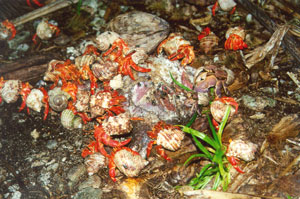 Kar Burns and Mark Smith, the camera man, chose a location for the taphonomy
experiment and set up Kar’s time-lapse camera to take a flash photo every
10 minutes. Mark set up one of his cameras to take a photo once per minute.
This evening, Kar and Robin Acker will place screws into the pig bones so
that metal detectors can find the pieces the crabs take away. They’ll set
up the experiment this morning after Ric has metal detected the site to be
sure there isn’t pre-existing noise. Kar Burns and Mark Smith, the camera man, chose a location for the taphonomy
experiment and set up Kar’s time-lapse camera to take a flash photo every
10 minutes. Mark set up one of his cameras to take a photo once per minute.
This evening, Kar and Robin Acker will place screws into the pig bones so
that metal detectors can find the pieces the crabs take away. They’ll set
up the experiment this morning after Ric has metal detected the site to be
sure there isn’t pre-existing noise.
The 2001 taphonomy experiment, using a lamb shoulder. Strawberry hermit
crabs simply set up housekeeping at the site.
Ric took the new folks on a hike around the “corner”
to the village, while Gary Quigg and a group worked in from the landing to the
cistern, where they met up with Ric and his gang. After discussion, they decided
not to cut a trail, but to walk around on the shoreline each day; it only took
about 15 minutes and making a trail would be very difficult, as the jungle
is quite a bit thicker than it was last trip. 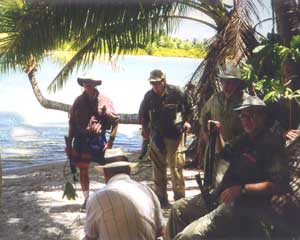 The
island has sustained more storm damage since 2003. The “shark tree”
– so named because baby black tip sharks congregate in its shade – has
lost its head and is now resting in the water and on the shore line. The
island has sustained more storm damage since 2003. The “shark tree”
– so named because baby black tip sharks congregate in its shade – has
lost its head and is now resting in the water and on the shore line.
The shark tree in 1997.
The radio shack (WI15b), which was flattened but complete in 2003, is
now a bare slab of concrete with the debris of the roof and contents scattered
nearby in the jungle in a tangle of wreckage. The shore line has move a
lot as well; Gardner 1, the surveyed datum point for the village, is now
three meters from shore in the lagoon. Today’s plan: High tide is at 0850. John Clauss will take the launch into
the lagoon and establish a fuel dump, using the tide to make his way through
the passage. Tom King and Gary Quigg will take a team to the carpenter’s
shop to begin an assessment and lay out some blocks while Ric does the
metal detecting at the taphonomy experiment site. Once the launch is available
for use a group will split off and head for the Seven Site to reconnoiter
and possibly begin clearing.
|
| Dateline: At sea, 1430 Local Time,
18 July 2007. |
ETA is now about 1400 local
time on the 19th. Seas were running so high last night that the
boat’s speed
was reduced to about 6 knots. The later arrival means they will miss the
morning’s high tide and won’t be able to get the launch into
the lagoon until the next morning.
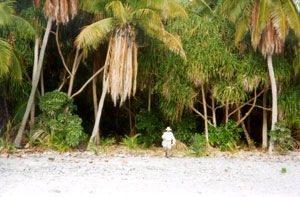 There was a team meeting and briefing in the morning to prepare and plan
for the first day ashore. The group, like Gaul, will divide into three parts.
Tom King will take a team to begin building the trail from the landing to
the lagoon so that equipment and people can move easily from shore to shore.
Ric will take the new people along the shore line from the landing to the
village (WD21d to WI15b), to look at the coast line and examine changes in
terrain. From the village, they will then flag a trail to the cistern (WG17b)
and meet up with Gary Quigg and a third team who will flag toward the cistern
from the landing. The two teams will then cut that trail. There was a team meeting and briefing in the morning to prepare and plan
for the first day ashore. The group, like Gaul, will divide into three parts.
Tom King will take a team to begin building the trail from the landing to
the lagoon so that equipment and people can move easily from shore to shore.
Ric will take the new people along the shore line from the landing to the
village (WD21d to WI15b), to look at the coast line and examine changes in
terrain. From the village, they will then flag a trail to the cistern (WG17b)
and meet up with Gary Quigg and a third team who will flag toward the cistern
from the landing. The two teams will then cut that trail.
At low tide John Clauss will set up the tide gauge in the channel. This
consists of banging a piece of re-bar into a crack in the reef, then mounting
a PVC pipe on it marked into easily-read increments. While all this is going
on, Kar Burns will be choosing a place to set up the taphonomy experiment,
which will be organized in the morning.
The weather is good, the sea has abated. The outside world has been purged
from recent memory; now it is Nikumaroro, the work, the team; no other reality
exists.
|
| Dateline: At sea, 0800 Fiji Time,
17 July 2007. 10°31′7″ South, 177°35′6″ West. |
 Average speed still 8 knots. About 400
miles out; ETA Nikumaroro about 1000 on the 19th, local time.
Occasional monster rolls knock the unwary off their feet and shower the salon
with jam jars and salt shakers. Some work is getting done, though: the air-powered
loppers have been assembled and are working correctly in spite of the ups
and downs. Average speed still 8 knots. About 400
miles out; ETA Nikumaroro about 1000 on the 19th, local time.
Occasional monster rolls knock the unwary off their feet and shower the salon
with jam jars and salt shakers. Some work is getting done, though: the air-powered
loppers have been assembled and are working correctly in spite of the ups
and downs.
An exciting afternoon en route in 2001.
|
| Dateline: At sea, 1200 Fiji Time,
16 July 2007. 13°00′0″ South, 178°47′0″ West. |
A formal position report
from Nai’a. ETA Nikumaroro is the 19th at about 1030 local time.
Making an average of 8 knots due to the seas which slow them down some. As
the day goes on the sea state should reduce which will help everyone adjust.
Everyone’s just being careful about what they eat and what they look at.
One or two people are living outdoors, wind, spray and all, for the fresh
air. Dry land will be a relief! |
|
Dateline: At sea, about 1330 local time, 15 July
2007. |
 Twenty-four hours out of Lautoka, Nai’a is
facing substantial seas and the team is facing substantial seasickness. Everyone
is laying very low indeed, and subsisting on ginger ale and meclazine hydrochloride,
better known as Anti-Vert. The crew has rigged the sail to help steady the
boat but even so, 120 feet of steel and a few yards of canvas are no match
for the Pacific. Seas are coming over the bow and it’s difficult to find a place
to acquire a satellite without drowning the phone. Twenty-four hours out of Lautoka, Nai’a is
facing substantial seas and the team is facing substantial seasickness. Everyone
is laying very low indeed, and subsisting on ginger ale and meclazine hydrochloride,
better known as Anti-Vert. The crew has rigged the sail to help steady the
boat but even so, 120 feet of steel and a few yards of canvas are no match
for the Pacific. Seas are coming over the bow and it’s difficult to find a place
to acquire a satellite without drowning the phone.
Crashing through waves in 1997. TIGHAR photo by J. Clauss.
|
|
Dateline: Lautoka, Fiji, about 1400 local time, 14 July 2007. |
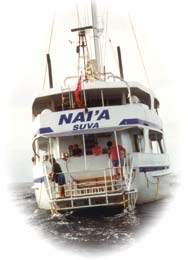 Under way, with all goods and hands stowed and the satphone found. Next
stop, Nikumaroro, 1,000 miles and five days distant. Everything has gone
smoothly, which makes them wonder what they’ve missed. After the rush of
logistical arrangements and an 11 hour flight, now it’s time to get some
serious sleep while the world turns underneath the boat. Under way, with all goods and hands stowed and the satphone found. Next
stop, Nikumaroro, 1,000 miles and five days distant. Everything has gone
smoothly, which makes them wonder what they’ve missed. After the rush of
logistical arrangements and an 11 hour flight, now it’s time to get some
serious sleep while the world turns underneath the boat.
Nai’a at sea, 1997. Photo courtesy John Clauss. |
|

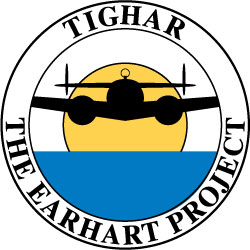

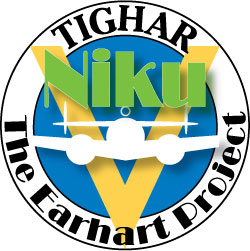
 In
the village, four of the crew from Nai’a volunteered to
help clear brush, resulting in about a 400% increase in productivity. Although
the work cannot be made light, many hands do help spread the load. All brush
is being cleared to the concrete slab of the Rest House to avoid piling it
on a potential archeological unit. They are finding lots of ... well, junk
is the best word, really – the debris of the village that wasn’t
worth moving in 1964. The area known as “dado alley” is cordoned
off for intensive metal detecting; this is where several heat shields were
found in 2003, apparently scattered by storm and wave action. All of this
activity is of great interest to the kia kias (Gygis alba) who are
just fledging, and who want to participate. Because Nikumaroro is so isolated
and so little visited by people, the wildlife population is lush and bold – or,
as the kia kias’ parents say, completely clueless.
In
the village, four of the crew from Nai’a volunteered to
help clear brush, resulting in about a 400% increase in productivity. Although
the work cannot be made light, many hands do help spread the load. All brush
is being cleared to the concrete slab of the Rest House to avoid piling it
on a potential archeological unit. They are finding lots of ... well, junk
is the best word, really – the debris of the village that wasn’t
worth moving in 1964. The area known as “dado alley” is cordoned
off for intensive metal detecting; this is where several heat shields were
found in 2003, apparently scattered by storm and wave action. All of this
activity is of great interest to the kia kias (Gygis alba) who are
just fledging, and who want to participate. Because Nikumaroro is so isolated
and so little visited by people, the wildlife population is lush and bold – or,
as the kia kias’ parents say, completely clueless. Kar Burns and Mark Smith, the camera man, chose a location for the taphonomy
experiment and set up Kar’s time-lapse camera to take a flash photo every
10 minutes. Mark set up one of his cameras to take a photo once per minute.
This evening, Kar and Robin Acker will place screws into the pig bones so
that metal detectors can find the pieces the crabs take away. They’ll set
up the experiment this morning after Ric has metal detected the site to be
sure there isn’t pre-existing noise.
Kar Burns and Mark Smith, the camera man, chose a location for the taphonomy
experiment and set up Kar’s time-lapse camera to take a flash photo every
10 minutes. Mark set up one of his cameras to take a photo once per minute.
This evening, Kar and Robin Acker will place screws into the pig bones so
that metal detectors can find the pieces the crabs take away. They’ll set
up the experiment this morning after Ric has metal detected the site to be
sure there isn’t pre-existing noise. The
island has sustained more storm damage since 2003. The “shark tree”
– so named because baby black tip sharks congregate in its shade – has
lost its head and is now resting in the water and on the shore line.
The
island has sustained more storm damage since 2003. The “shark tree”
– so named because baby black tip sharks congregate in its shade – has
lost its head and is now resting in the water and on the shore line.
 There was a team meeting and briefing in the morning to prepare and plan
for the first day ashore. The group, like Gaul, will divide into three parts.
Tom King will take a team to begin building the trail from the landing to
the lagoon so that equipment and people can move easily from shore to shore.
Ric will take the new people along the shore line from the landing to the
village (WD21d to WI15b), to look at the coast line and examine changes in
terrain. From the village, they will then flag a trail to the cistern (WG17b)
and meet up with Gary Quigg and a third team who will flag toward the cistern
from the landing. The two teams will then cut that trail.
There was a team meeting and briefing in the morning to prepare and plan
for the first day ashore. The group, like Gaul, will divide into three parts.
Tom King will take a team to begin building the trail from the landing to
the lagoon so that equipment and people can move easily from shore to shore.
Ric will take the new people along the shore line from the landing to the
village (WD21d to WI15b), to look at the coast line and examine changes in
terrain. From the village, they will then flag a trail to the cistern (WG17b)
and meet up with Gary Quigg and a third team who will flag toward the cistern
from the landing. The two teams will then cut that trail. Average speed still 8 knots. About 400
miles out; ETA Nikumaroro about 1000 on the 19th, local time.
Occasional monster rolls knock the unwary off their feet and shower the salon
with jam jars and salt shakers. Some work is getting done, though: the air-powered
loppers have been assembled and are working correctly in spite of the ups
and downs.
Average speed still 8 knots. About 400
miles out; ETA Nikumaroro about 1000 on the 19th, local time.
Occasional monster rolls knock the unwary off their feet and shower the salon
with jam jars and salt shakers. Some work is getting done, though: the air-powered
loppers have been assembled and are working correctly in spite of the ups
and downs. Twenty-four hours out of Lautoka, Nai’a is
facing substantial seas and the team is facing substantial seasickness. Everyone
is laying very low indeed, and subsisting on ginger ale and meclazine hydrochloride,
better known as Anti-Vert. The crew has rigged the sail to help steady the
boat but even so, 120 feet of steel and a few yards of canvas are no match
for the Pacific. Seas are coming over the bow and it’s difficult to find a place
to acquire a satellite without drowning the phone.
Twenty-four hours out of Lautoka, Nai’a is
facing substantial seas and the team is facing substantial seasickness. Everyone
is laying very low indeed, and subsisting on ginger ale and meclazine hydrochloride,
better known as Anti-Vert. The crew has rigged the sail to help steady the
boat but even so, 120 feet of steel and a few yards of canvas are no match
for the Pacific. Seas are coming over the bow and it’s difficult to find a place
to acquire a satellite without drowning the phone. Under way, with all goods and hands stowed and the satphone found. Next
stop, Nikumaroro, 1,000 miles and five days distant. Everything has gone
smoothly, which makes them wonder what they’ve missed. After the rush of
logistical arrangements and an 11 hour flight, now it’s time to get some
serious sleep while the world turns underneath the boat.
Under way, with all goods and hands stowed and the satphone found. Next
stop, Nikumaroro, 1,000 miles and five days distant. Everything has gone
smoothly, which makes them wonder what they’ve missed. After the rush of
logistical arrangements and an 11 hour flight, now it’s time to get some
serious sleep while the world turns underneath the boat.